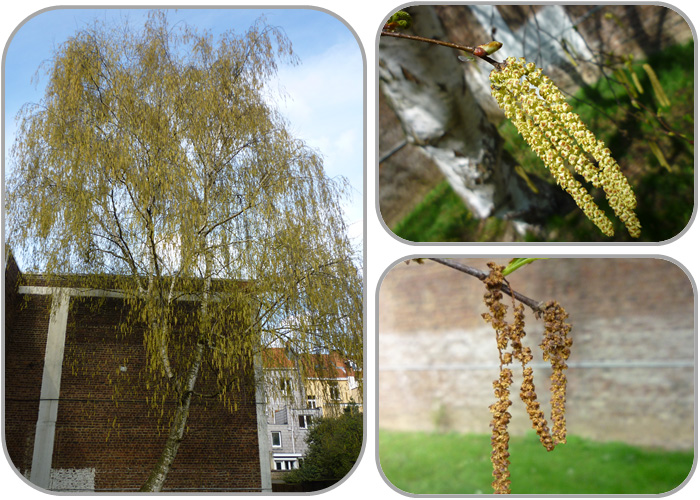Le bouleau (Betula spp.)
Famille: Betulaceae
Floraison: Fin mars - Mai
Caractéristiques:
L’arbre peut atteindre une taille jusqu’à 30 m de hauteur. Les feuilles sont alternes et doublement dentées. Le tronc, blanc et noir caractéristique, est également lisse. Les fleurs mâles et femelles sont regroupées en chatons distincts. Ils produisent de grandes quantités de grains de pollen allergisants (1/3 de l'ensemble des grains de pollen présents dans l'air).
Répartition:
Les espèces les plus communes en Belgique sont le bouleau verruqueux (Betula pendula syn.: B. verrucosa et B. alba) et le bouleau pubescent (B. pubescens). Ces arbres aiment la lumière et ils sont de ce fait parmi les premiers arbres colonisant les régions déboisées. Ils sont présents sur les sols pauvres, sablonneux, secs à humides, acides.
Allergie:
En Belgique, le pollen de bouleau est le principal responsable des allergies aux pollens d’arbre. Sa concentration dans l’air est fortement variable d’une région à l’autre du pays. A la mer, l’air est généralement moins riche en pollen. Un séjour à la côte est donc bénéfique aux personnes souffrant d'allergie au pollen de bouleau.
D’une année à l’autre, des variations du nombre de grains récoltés dans l’air sont observées. La concentration pollinique de l'air est influencée par le biorythme de la plante (à une année de forte production de pollen de bouleau succèdent souvent deux années de production moindre), et par les conditions atmosphériques lors de la formation des inflorescences et de la libération du pollen. La pluie lessive généralement l’air du pollen.
Allergies croisées : Tout comme le noisetier (Corylus), l'aulne (Alnus) et le charme (Carpinus), le bouleau appartient à la famille bétulacées et une allergie croisée entre les pollens de ces différentes espèces existe. Une personne sensibilisée au pollen de bouleau peut présenter des problèmes d'allergie au début de l'année, lorsque les concentrations en pollen d'aulne et de noisetier sont très élevées. Signalons également que certaines personnes allergiques au pollen de bouleau présentent une allergie alimentaire vis-à-vis de certains fruits (pommes, cerises, amandes, noisettes, kiwis). La consommation de ces fruits crus peut entraîner des problèmes de prurit et d’oedème labial.







